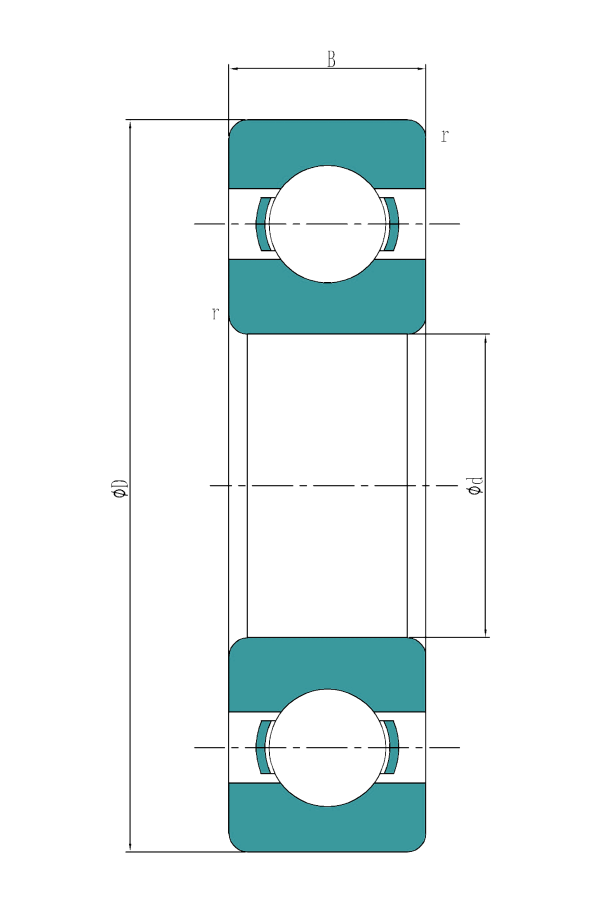
Image may differ from product. See technical specification for details.
Search for the bearing model you need
Shaft abutment diameter (da)
GB,ASTM/AISI,ГОСТ,BS,JIS,NF,DIN / VDEh
Material
Silicon Nitride, Zirconium Oxide, Aluminum Oxide, Silicon Carbide
Inner ring diameter
4mm-20mm
Outer ring diameter
13mm-32mm
Weight
0.55g-8.8g
Brand
QIBR/OEM/Neutral
Package
QIBR/Standard Industrial Package/OEM
Applications
Machine tool spindle, centrifuge, booster pump, oil pump, blower, various gearboxes, laboratory equipment

| NO. | Product | Product Number | Basic load rating | Inner diameter (d) | Mass | Outer diameter (D) | Chamfer dimension (r) | Width (B) |
|---|---|---|---|---|---|---|---|---|
| 1 |

|
624 | 2.84 N | 4 mm | 0.55 g | 13 mm | 0.2 mm | 5 mm |
| 2 |

|
625 | 5.88 N | 5 mm | 0.9 g | 16 mm | 0.3 mm | 5 mm |
| 3 |

|
605 | 3.92 N | 5 mm | 0.65 g | 14 mm | 0.3 mm | 5 mm |
| 4 |

|
626 | 6.86 N | 6 mm | 1.5 g | 19 mm | 0.3 mm | 6 mm |
| 5 |

|
606 | 6.86 N | 6 mm | 1.2 g | 17 mm | 0.6 mm | 6 mm |
| 6 |

|
696 | 4.9 N | 6 mm | 0.75 g | 15 mm | 0.6 mm | 5 mm |
| 7 |

|
628 | 12.74 N | 8 mm | 3.2 g | 24 mm | 0.2 mm | 8 mm |
| 8 |

|
608 | 12.74 N | 8 mm | 2.4 g | 22 mm | 0.3 mm | 7 mm |
| 9 |

|
698 | 5.88 N | 8 mm | 1.3 g | 19 mm | 0.3 mm | 6 mm |
| 10 |

|
6200 | 21.56 N | 10 mm | 5.6 g | 30 mm | 0.3 mm | 9 mm |
| 11 |

|
6000 | 12.74 N | 10 mm | 3.5 g | 26 mm | 0.6 mm | 8 mm |
| 12 |

|
6900 | 12.74 N | 10 mm | 1.9 g | 22 mm | 1 mm | 6 mm |
| 13 |

|
6201 | 24.50 N | 12 mm | 7 g | 32 mm | 0.2 mm | 10 mm |
| 14 |

|
6001 | 15.68 N | 12 mm | 4 g | 28 mm | 0.3 mm | 8 mm |
| 15 |

|
6901 | 11.76 N | 12 mm | 1.9 g | 24 mm | 0.3 mm | 6 mm |
| 16 |

|
6202 | 29.40 N | 15 mm | 8.8 g | 35 mm | 0.3 mm | 11 mm |
| 17 |

|
6002 | 24.50 N | 15 mm | 5.7 g | 32 mm | 0.6 mm | 9 mm |
| 18 |

|
6902 | 15.68 N | 15 mm | 3 g | 28 mm | 1 mm | 7 mm |
| 19 |

|
6203 | 39.20 N | 17 mm | 12.8 g | 40 mm | 0.2 mm | 12 mm |
| 20 |

|
6003 | 29.40 N | 17 mm | 7.3 g | 35 mm | 0.3 mm | 10 mm |
| 21 |

|
6903 | 19.60 N | 17 mm | 3.3 g | 30 mm | 0.3 mm | 7 mm |
| 22 |

|
6204 | 49.00 N | 20 mm | 20 g | 47 mm | 0.3 mm | 14 mm |
| 23 |

|
6004 | 35.28 N | 20 mm | 12.6 g | 42 mm | 0.6 mm | 12 mm |
| 24 |

|
6904 | 32.34 N | 20 mm | 8.8 g | 37 mm | 1 mm | 9 mm |
Features and advantages of QIBR ceramic deep groove ball bearings
QIBR ceramic deep groove ball bearings are engineered to address critical operational demands in various industrial fields, offering the following key advantages:
1. Superior wear resistance
QIBR ceramic bearings exhibit exceptional hardness and wear resistance. Unlike traditional steel bearings, the rolling elements in ceramic bearings are highly durable, particularly in high-load and high-frequency applications.
2. Reduced friction coefficient
Ceramic balls have a lower friction coefficient compared to steel balls. This reduces energy loss, enhances operational efficiency, and minimizes heat generation during high-speed operations.
3. Exceptional corrosion resistance
Ceramic materials resist moisture, acids, alkalis, and other chemicals, making these bearings ideal for harsh environments such as chemical, marine, and food processing industries.
4. Outstanding high-temperature performance
Ceramic materials maintain their strength and hardness at elevated temperatures, often surpassing the tolerance of steel. As a result, QIBR ceramic bearings are widely used in high-temperature applications, including aerospace and metallurgy.
Performance enhancements for QIBR ceramic deep groove ball bearings
1. Improving material purity and uniformity
The performance of ceramic balls directly impacts the overall bearing quality. Enhancing material purity increases hardness, wear resistance, and corrosion resistance, thereby extending bearing life.
2. Optimizing microstructure
Refining the grain structure of ceramic materials enhances their compressive strength, impact resistance, and internal stress distribution, reducing the likelihood of material failure or performance degradation.
3. Utilizing dry lubrication
Ceramic bearings are particularly suited for environments requiring oil-free lubrication or extreme conditions like vacuum, low temperatures, or high temperatures. Choosing the right dry lubricant can further improve performance under such circumstances.
4. Improving groove design
Enhancements to the deep groove design, such as adjusting groove depth or increasing the contact area between the inner and outer rings, can optimize load capacity and improve operational stability.
Primary application fields of QIBR ceramic deep groove ball bearings
1. High-speed machinery
With their low friction coefficient and high hardness, ceramic bearings reduce frictional heat generation, making them ideal for high-speed machinery.
2. Precision instruments and equipment
The low friction and noise characteristics of ceramic bearings ensure high accuracy and stability in precision instruments.
3. Electronics
Ceramic bearings help reduce heat generation, extend the lifespan of electronic devices, and are lightweight, making them suitable for applications with strict weight requirements.
4. Medical equipment
Ceramic materials are rust-resistant and corrosion-resistant, making them ideal for demanding medical environments. Additionally, their low friction reduces mechanical wear and heat generation, enhancing equipment reliability and stability.


